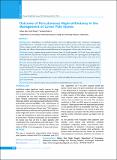Please use this identifier to cite or link to this item:
https://hdl.handle.net/20.500.14356/1543| Title: | Outcome of Percutaneous Nephrolithotomy in the Management of Lower Pole Stones |
| Authors: | Dongol, Udaya Man Singh Bohora, Sandeep |
| Citation: | DongolU. M. S., & BohoraS. (2018). Outcome of Percutaneous Nephrolithotomy in the Management of Lower Pole Stones. Journal of Nepal Health Research Council, 16(3), 274-278. https://doi.org/10.33314/jnhrc.v16i3.1427 |
| Issue Date: | 2018 |
| Publisher: | Nepal Health Research Council |
| Article Type: | Original Article |
| Keywords: | Lower calyx Lower pole stones Percutaneous nephrolithotomy Stone free rate |
| Series/Report no.: | Jul-Sep 2018;1427 |
| Abstract: | Abstract Background: Urolithiasis is a worldwide problem due to its high prevalence and recurrence. Percutaneous nephrolithotomy is a minimally invasive surgical option for the treatment of large renal stone burden greater than 20mm, staghorn calculi and lower pole calyceal stone greater than 10 mm. The objective of this study was to evaluate the safety and efficacy of percutaneous nephrolithotomy in the management of lower pole calyceal stones. Methods: Seventy patients who presented in between June 2013 and September 2017 with lower pole calyceal stones and lower calyceal stones with pelvic extension were included in the study. The operating time, the hospital stay, complications rate, stone clearance rate were all noted. Patients were followed up in three and six weeks with X-ray KUB and ultrasonography of abdomen. Results: Seventy adult patients with lower pole calyceal stones underwent standard percutaneous nephrolithotomy. The mean age was 32 years (18-71 yrs). The mean stone size was 17.6 mm (15 –28 mm). The mean operating time was 62 minutes (48-124 mins) and hospital stay was 4.1 days(4-8 days). The stone clearance rate was 92.6% for stone <20mm and 90.7% stone size >20 mm. The complications noted were fever (8.5%), transient haematuria (20%), urine leak (5.7%), obstruction by residual fragments (5.7%) and one pseudoaneurysm(1.42%). Seven patients (10%) needed blood transfusion. Conclusions: Percutaneous nephrolithotomy is a safe, feasible and highly effective method for the treatment of lower pole calyceal stones. Keywords: Lower calyx; lower pole stones; percutaneous nephrolithotomy; stone free rate. |
| Description: | Original Article |
| URI: | http://103.69.126.140:8080/handle/20.500.14356/1543 |
| ISSN: | Print ISSN: 1727-5482; Online ISSN: 1999-6217 |
| Appears in Collections: | Vol. 16 No. 3 Issue 40 Jul - Sep 2018 |
Files in This Item:
| File | Description | Size | Format | |
|---|---|---|---|---|
| 1427-Manuscript-6628-1-10-20181030.pdf | Fulltext Article. | 197.16 kB | Adobe PDF |  View/Open |
Items in DSpace are protected by copyright, with all rights reserved, unless otherwise indicated.
